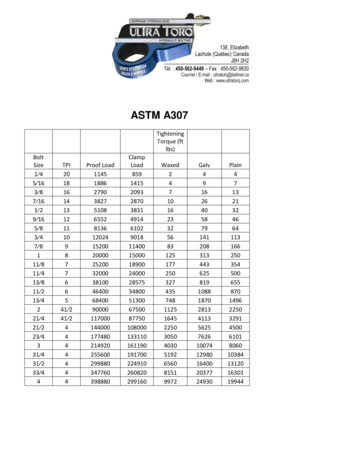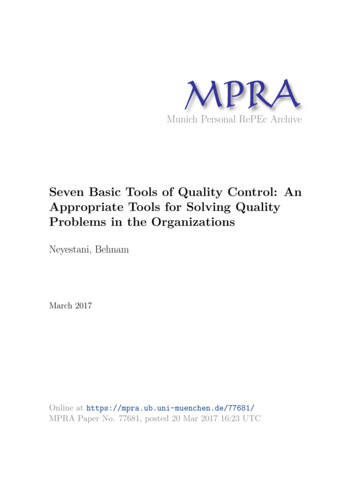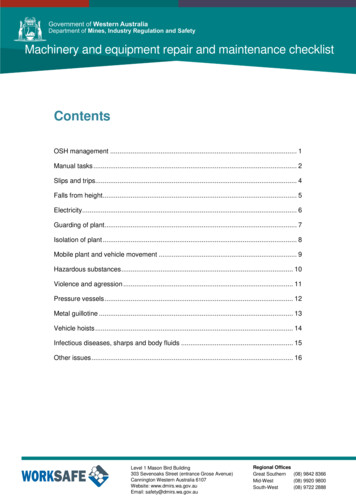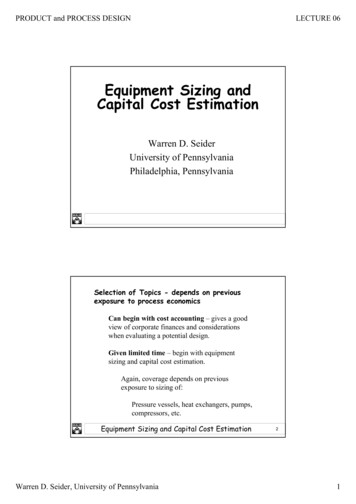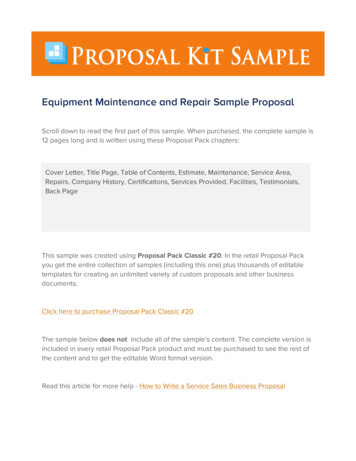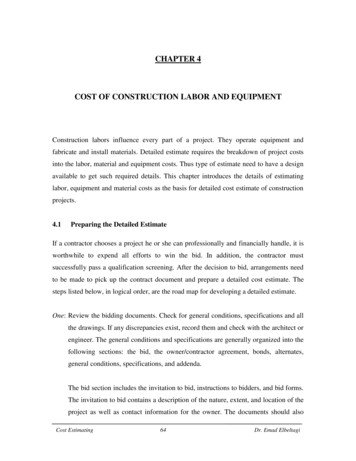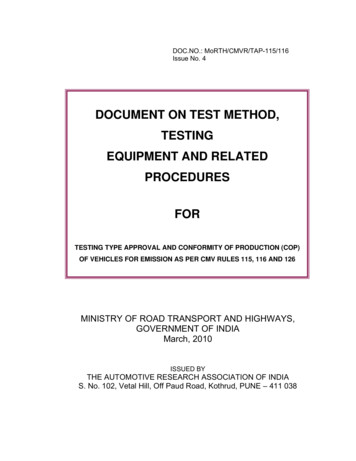
Transcription
CHAPTERT O O L SA N D3E Q U I P M E N T
3OOLS AND EQUIPMENTTOOLS AND EQUIPMENT3.1 Importance of Tools and EquipmentBUILDING RURAL ROADSProper tools and equipment are essentialfor the effective operation of any civilworks site. Equipping the constructionsite with the correct tools and equipmentplays an essential role in achievingtimely and good quality results. For everyconstruction activity there is an optimalcombination of tools, equipment andlabour. Depending on the nature andcontent of the works, the technical staffneeds to know which tools to use andhow to effectively combine them withmanual labour.Once on site, equipment requires trainedoperators and supervisory staff whoare prof icient in its operation andmaintenance.Faulty equipment is a common reasonfor delays on construction sites. Amajor responsibility of the projectmanagement is to ensure that tools andequipment are maintained in a goodcondition and are readily availablewhen required for the various workactivities.W hen applying labour-based workmethods, the use of hand tools supportedwith selected items of light equipmentcan produce results comparable withthose achieved when using only heavyequipment. For every constructionactivity there is an optimum combinationof equipment and labour. In order toutilize the equipment and labour in themost effective way, the use of equipmentneeds to be carefully coordinated withthe output of the work gangs.For certain construction activities,particularly hauling of materials andcompaction, high labour productivityand good quality of work may bedifficult to achieve using only manual1 1 6
3.2 Quality of Toolslabour and hand tools. In such cases,using light construction equipment canincrease the efficiency of work.Site supervisors need to know how touse the tools and how to operate theequipment in order to secure goodwork progress and the expected highquality results. It is also important thatstaff know the full potential, as well asthe limitation, of the use of manual andequipment-based works methods.Providing workers with strong, durabletools helps to increase productivity. Ifthe workers discover that their tools arenot very strong, they will tend to usethem more gently, and less productivelyso as to avoid breaking them. Brokentools on site cause interruptions to work,and reduces productivity, while the toolsare repaired or replaced.Ergonomically efficient hand tools arecomfortable to use, well adapted toparticular construction tasks and suit thephysical characteristics of the workers.Ergonomically efficient tools and correctworking techniques allow the workers touse the major body muscles effectivelyand make the most productive use of theirenergy. The proper use of suitable toolswill also prevent injuries on site.BUILDING RURAL ROADSFinally, tools and equipment need regularmaintenance, requiring good workshopfacilities, a reliable supply of spare partsand qualified mechanical staff.Ha nd tools a re used much moreintensively on labour-based constructionwork than in agriculture. Many toolscommonly used for agriculture workare not strong enough for use onconstruction sites and will quicklybreak if used intensively. It is thereforeessential that the tools used on a civilworks project are properly designedto stand the heavy wear and tear of aconstruction site.3TOOLS AND EQUIPMENTHand tools are the main instrumentsused by the workers to carry out theactivities involved in building a roadusing labour-based work methods.It is therefore important that projectstaff know how to select and maintainthe tools since they have a significantinfluence on the work outputs.1 1 7
3.3 Characteristics of Suitable Hand Tools3TOOLS AND EQUIPMENTHand tools should be of good qualityand designed so that they are efficientin use. The tools should be strongenough to withstand intensive use atthe work site, and resistant to wear sothat they have a long working life. Formost tools this means that the metalhead should be made from carbonsteel, heat-treated to give the correctstrength and wear characteristics. Forthe main excavation and striking toolssuch as hoes, pickaxes, mattocks andsledgehammers, the tool heads shouldbe forged in a single piece. Cast orfabricated and welded tool heads do notprovide sufficient quality.The timber handle should be madefrom a tough, preferably light, seasonedhardwood. The wood should be straightgrained, with the grain lying alongthe length of the handle. The handlesshould not have any splits or knots,since these lead to handles breakingwhen used.Tool handles should be smoothlyfinished and carefully shaped witha raised grip at the end to preventthe workers hands sliding off. Longhandled tools are generally preferredsince they allow the workers to stand inan upright position, which is less tiringthan having to bend or crouch down.The handle should be a tight, secure fitin the head of the tool.Good quality tools are inevitably moreexpensive than poor quality tools.However, it is wrong simply to purchasethe cheapest tools available. This willonly result in problems on site, andthe need for the frequent replacementof broken tools. Efficient hand toolsallow workers to achieve the maximumproductivity from their efforts. Efficienttool heads should: have the correct shape in orderto work efficiently, be of suitable weight for thestrength of the workers, andBUILDING RURAL ROADS1 1 8
be properly sharpened along theworking edges.The optimal choice of tools also variesfrom place to place, depending on the siteconditions, type of works carried out,type of soils and local skills and practice.Site supervisory staff needs to be trainedin the proper use and maintenance oftools. Since the labour is temporarilyemployed, they are not provided withany formal training in the use of handtools. However, the supervisors areresponsible for instructing the workersand ensuring that tools are properly usedand maintained.The workers are often very conservativeconcerning the use of hand tools. Localtraditions may create some reluctanceamong workers to use new tools. WhenHoesThe hoe, in addition to being veryuseful in agriculture, is also a commonlyused tool when using labour-based workmethods for rural road works. It can beused for excavating soft soils and is oftenused in combination with stretchers orhead baskets. Hoes are also effectivewhen excavating drains, cutting backslopes and removing topsoil. The mostefficient way of using the hoe is whenthe workers can stand slightly below thelevel being excavated.3TOOLS AND EQUIPMENTIt is possible to obtain good quality,efficient tools manufactured locally.Before extensive purchases of tools aremade, their cost, strength, durabilitya nd de si g n s hou ld b e c a re f u l lyevaluated.new tools are introduced, it is importantto provide adequate instruction in theirproper use. It is also worthwhile toassess the effectiveness of the new toolsas compared to the local traditionalwork methods.As it is commonly found and used infarming communities, its use is wellknown among the workers and wouldnormally not need any instruction inhow it is effectively used.Hoes are produced in a variety of shapes.BUILDING RURAL ROADS1 1 9
3TOOLS AND EQUIPMENTThey consist of a blade and a handle.Both pieces are commonly found inlocal markets. Local workshops andblacksmiths can provide repairs andmaintenance for this tool.The hoe should have a handle of suitablelength so that the worker can workstanding upright. Handles used forhoes vary in length. The most commondimensions are from 70cm to 1.3m.The blade of the common hoe has astraight cutting edge. Narrow bladesare useful for excavating hard or stonysoils, and are used as an alternative tothe pickaxe. Wider blades are effectivefor spreading and levelling works. Thestandard digging hoe has a blade widthof 20 to 25 centimetres and a length ofaround 25 cm.Good handles are manufactured fromseasoned hardwood. R ather thanproducing spare handles on site, it isrecommended to purchase qualityhandles made by skilled artisans usinghigh-grade materials.The eye can be round or oval, althoughfor excavation works the oval eye isrecommended. Replacing the handleis easier with the round eye. Thedisadvantage is that blades with a roundeye tend to turn while working in hardsoils.BUILDING RURAL ROADSPickaxes and MattocksPickaxes and mattocks are tools used forexcavating hard or stony soils, difficultto penetrate with hoes. Pickaxes areeffective when breaking hard or stonyground. When excavating side drainsin hard soils, the pickaxe is particularlyeffective. Mattocks are useful forshaping slopes in hard soils, and alsoto cut roots. Make sure whoever isoperating a pickaxe has sufficient spaceto operate by ensuring that all otherworkers are at a safe distance.Both these tools always come withan oval shaped eye so that the handle1 2 0
3cannot turn in the eye. Both thepickaxe and the mattock are ratherheavy. The pickaxe usually weighsbetween 2.7 and 3.6kg and the mattockbetween 1.8 and 2.7kg. For this reason,it is important that they are fitted withproperly shaped, good quality handles.Loose handles on these tools are apotential hazard to the workers.Handles for these tools are producedin a variety of lengths, each designedfor specific work activities. Shorterhandles, ranging from 0.6 to 1.2 metresin length, are commonly used onspades and shovels primarily used forexcavation works. Longer handles (1.2- 1.4 metres) are more useful when thetools are used for loading and throwing.The advantage of a long-handled shovelis particularly clear when loading into ahigh-sided truck or throwing materialBUILDING RURAL ROADSAs they are double edge striking tools,they are fitted with a straight handlewith an elliptical rather than circularcross-section. The handle shouldpreferably be provided with a raisedsafety grip, which prevents it fromslipping out of the worker's hands.A spade has a stronger square shapedblade and is primarily intended fordigging in denser soils and is lesssuitable for t hrowing or loadingactivities. The spade is essentially aheavy-duty forged tool. In hard soils,the spade is more efficient because itcan be pushed into the ground withoutbending the blade. Placing a foot onthe top of the blade and pressing itdown increases the pushing force.This however requires that the workeris provided with boots or shoes withhard soles.TOOLS AND EQUIPMENTShovels and SpadesShovels are used for scooping upmaterial and loading it on to a trailer,truck or wheelbarrow, or throwingit directly to where the material isneeded. The shovel has a rounded orpointed blade making it suitable forboth digging and loading purposes.1 2 1
out of a deep trench. Long handledshovels are also used for cleaningculvert pipes.3TOOLS AND EQUIPMENTShovels and spades should not havesharp joints, which may da maget he ha nds of t he workers. L oosehilts or handles need to be repairedimmediately, so they do not cause harmto the workers. Loose or faulty handlesalso compromise the performance ofthe workforce.BUILDING RURAL ROADSSpades a nd shovels provide a nalternative to hoes. The optimal choicedepends on the prevailing soil andworking conditions and the choice ofhaulage methods. The advantage ofusing shovels is mainly related to theireffectiveness when loading of throwingmaterials. A good example in thisrespect is when excavating side drains.Workers equipped with shovels can thenthrow the excavated materials from thedrain directly onto the road surface,which is then used to form the camber.CrowbarsThe crowbar, like the picka xe, ismostly used for penetrating or breakingup stony or hard soils. It is also usedfor moving boulders or heavy items, byusing it as a lever. The crowbar needsto be made from high-grade steel sothat it does not bend easily.Crowbars are usually manufacturedeither as round or octagonal sectionrod s. For i n f r a st r uc t u re work, adiameter of 30mm provides a good andfirm grip. The length should be from 1.5to 1.8 metres. With these dimensions,the crowbar gains sufficient weight topenetrate hard and compact soils andallows the worker to stand up rightwhen operating it. The bar can be fittedwith a pointed or a chisel end – or both.The pointed end is used to penetrateand break loose material, while thechisel end is more useful for leverage.Rakes and SpreadersRakes are used in road works forraking out vegetation from loose soil.Commercially produced rakes have 10to 16 teeth, each about 75 - 100mmlong, with an overall length about 400- 450mm.Spreaders are useful when forming thecamber and when spreading gravel.Spreaders are made of sheet metal (2- 3mm thick) with ridges on one side,which are used to level the road surfaceaccording to set levels and gradients.1 2 2
3TOOLS AND EQUIPMENTBUILDING RURAL ROADS1 2 3
The handles for both tools shouldbe long enough to allow the workerto operate comfortably in a standingposition.3TOOLS AND EQUIPMENTHand RammersHand rammers are used for compactingsoil and gravel. It consists of a weightwith a long handle.The effectiveness of a hand rammerdepends on its weight and the area thathits the ground. Ideally, the weightshould be as heavy as possible and thearea as small as possible (without therammer penetrating the soil). Theweight can be made of various materialssuch as steel, concrete or solid wood.Rammers made from concrete or woodcan be manufactured locally.A rammer that can be handled effectivelyby a worker should therefore have aweight of some 6 – 8kg. The diameterat the bottom end should be between 13to 15cm. The handle needs to be longenough to allow the workers to lift therammer without bending their back.Using hand rammers on large surfacesis expensive and diff icult to applyevenly. Hand rammers are most usefulin small and confined areas such asaround culverts, when filling potholesand other places where it is impracticalor difficult to access with rollers.BUILDING RURAL ROADSSawsSaws are manufactured in a numberof varieties. Cutting trees and bushesrequires
OOLS AND EQUIPMENT 3.1 Importance of Tools and Equipment Proper tools and equipment are essential for the effective operation of any civil works site.



